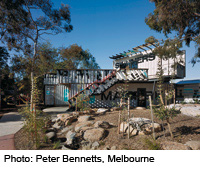Children's Activity Centre in Melbourne

In the middle of a playground in the south of Melbourne, an activity centre has been cre-
ated for children. Here, they can meet after school and do their homework, paint, make things with their hands, listen to music and participate in many other things. The budget for this project was very tight, and it was necessary to keep the maintenance costs as low as possible. At the same time, the energy and high spirits of the “masters of the house” also had to be taken into account. In addition, a short construction period was essential, since the entire site had to be kept open at all times.
The architects, who are experienced in re-
cycling materials, decided to employ four disused shipping containers. These were arranged and stacked in such a way that ample, multifunctional spaces were created for joint activities as well as quiet areas where children can withdraw. From every container there are links to the surroundings outside, and access is provided to the open air.
The design goals went even further, though. One aim was not to cause any waste as a result of the construction measures. Where doors and windows were cut in the sides of the containers, for example, the sheet metal was used to create balustrades, sunshading and other elements. The container doors were incorporated in the construction as a means of supporting the balconies, and any offcut timber was used as soffit cladding. The entire materials and building components contained in the centre are, therefore, recycled.
Carpet tiles were used as a lining to the internal surfaces. The tiles, adhesive fixed to chipboard, were laid in a two-colour pattern. To reduce the effects of solar radiation in summer, the insulation to the outer walls of the containers is lined with heat-reflecting aluminium foil. The raised roof terrace, the projecting areas of the containers set at an angle on the upper level, and the staircase structure all provide protection against direct insolation. The sheet-metal containers with their painted surfaces were deliberately left in their existing state with all signs of wear and tear as a record of their turbulent lives on the oceans of the world. Today, they have found a place of rest very near the harbour in Melbourne.
